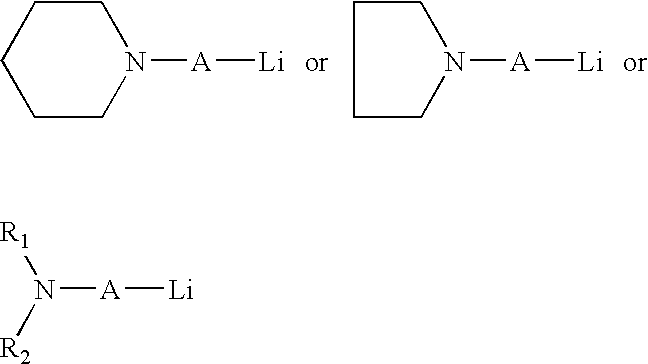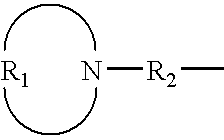Functionalized rubbery polymers
a rubbery polymer and functional technology, applied in the field of rubbery polymers, can solve the problems of lower rolling resistance of tires made therefrom and lower hysteresis value, and achieve the effects of improving polymer properties, low hysteresis, and good compatibility with fillers
- Summary
- Abstract
- Description
- Claims
- Application Information
AI Technical Summary
Benefits of technology
Problems solved by technology
Method used
Image
Examples
examples 1-5
[0078] In this series of experiments, 3,4-(2-N-alkylaminoethyl) styrene was prepared by the addition of the appropriate primary or secondary amine to a mixture of divinyl benzene in hexane solution the presence of n-butyl-lithium at 10° C.
[0079] In Example 1, 3,4-(2-N-butylaminoethyl) styrene was prepared using the general procedure described above. In the procedure used, one mole of divinyl benzene (60 / 40 mixture of both the para and meta isomers) and one mole of butyl amine in two liters of hexane solvent was added to a three neck flask equipped with an air driven motor under a nitrogen atmosphere. This solution was cooled to 10° C. and then 30 mmoles of butyl-lithium was added. The solution turned reddish in color. After one hour of reaction time the solvent was evaporated under a rotary vacuum to remove all of the hexane solvent. The residue was distilled under vacuum and the product that was isolated was determined to be a mixture of the 3,4-(2-N-butylaminoethyl) styrene.
[008...
example 6
[0084] In this experiment, the amine group on 3,4-(2-N-methylaminoethyl) styrene monomer was protected with chlorotrimetylsilane so that it could be polymerized with anionic initiators under solution polymerization conditions. In the procedure used a three neck flask was charged with one liter of hexane and one mole of the 3,4-(2-aminoethyl) styrene monomer synthesized in Example 2 and cooled to room temperature. Then, two moles of trimethychlorosilane was added drop wise at a very slow rate to the mixture. After the addition was completed the reaction mixture was neutralized with sodium carbonate. The hexane solvent was removed and the residue was vacuumed distilled. The resulting product was identified by C13 NMR as the 3,4-(2-N,N-di-trimethylsilylaminoethyl) styrene. This monomer having protected amine groups could then be used in anionic polymerizations.
example 7
[0085] A styrene butadiene rubber which is functionalized with 3,4-(2-aminoethyl) styrene monomer can be prepared by anionic solution polymerization by charging 2350 g of a silica / alumina / molecular sieve dried premix containing 19.50 weight percent styrene and 1,3-butadiene in hexanes into a one-gallon (3.8 liters) reactor. In such a polymerization, 4.6 grams of a neat 3,4-(2-N,N-di-trimethylsilylaminoethyl) styrene can be charged into the reactor which contains the styrene and butadiene monomers. Then, 2.9 ml of 1 M solution of N,N,N′,N′-tetramethyethylenediamine (TMEDA) and 2.3 ml of 1.6 M n-butyl lithium (n-BuLi) in hexanes were added to the reactor, respectively. Such a polymerization can be carried out at 70° C. for 90 minutes. All available monomer was consumed at which time, and then, ethanol was added to shortstop the polymerization. The functionalized styrene butadiene rubber can then be removed from the reactor and stabilized with 1 phm of antioxidant. After evaporating he...
PUM
| Property | Measurement | Unit |
|---|---|---|
| weight percent | aaaaa | aaaaa |
| temperature | aaaaa | aaaaa |
| Temperatures | aaaaa | aaaaa |
Abstract
Description
Claims
Application Information
 Login to View More
Login to View More - R&D
- Intellectual Property
- Life Sciences
- Materials
- Tech Scout
- Unparalleled Data Quality
- Higher Quality Content
- 60% Fewer Hallucinations
Browse by: Latest US Patents, China's latest patents, Technical Efficacy Thesaurus, Application Domain, Technology Topic, Popular Technical Reports.
© 2025 PatSnap. All rights reserved.Legal|Privacy policy|Modern Slavery Act Transparency Statement|Sitemap|About US| Contact US: help@patsnap.com



